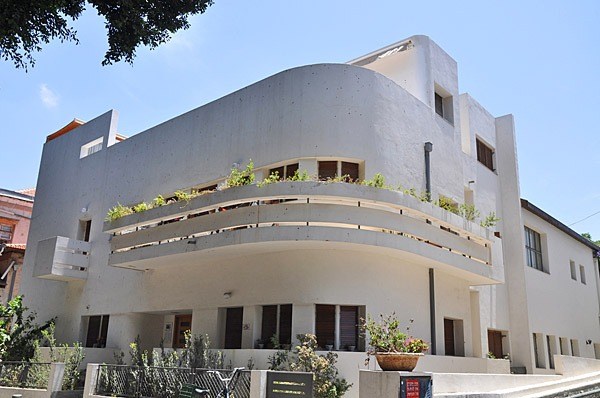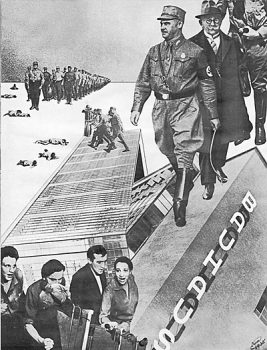by Thomas O’Dwyer

On April 1, one hundred years ago, Walter Gropius established the Bauhaus school of design in Weimar, central Germany. It lasted a mere 14 years — exactly the same time as the Weimar Republic. In 1933, the Nazis destroyed both. Short life or not, Bauhaus opened up a modern way of thinking about arts and crafts, the marriage of form and function, education, and the growth of cities. Its ideas have had an impact well beyond the school, its locations and its era. And there have been some resurrections. Sleepy Weimar has regained its pleasant obscurity and the recovery of Bauhaus has been a little uneven, but robust and international. Nazi thuggery was dealt a satisfying poke in the eye by one living monument to Bauhaus, the White City of Tel Aviv in Israel — a UNESCO World Heritage site.
Gropius’ revolutionary school of art and design was an achievement of modernism itself. It began as the Thuringian state Bauhaus in Weimar, moved as a school of design to Dessau, and finally as a private institute to Berlin. Its themes grew from an active arts and crafts movement and when the Nazis crushed it, these ideas flooded out of Germany with thousands of emigrants. The influence of Bauhaus has been immense, especially in the United States, where many artists moved before and during World War II. As well as Tel Aviv, built by Jewish German refugees, there are World Heritage Bauhaus sites in a dozen states around the world. The 100th anniversary this year is being marked by exhibitions, theatre, music and modern dance events. A flood of books has appeared, most destined to languish unread on post-Bauhaus bookshelves.
What the term Bauhaus means to the wider public today is hard to pin down.
It can be buildings with rounded balconies and white walls. There are Barcelona chairs, Wagenfeld table lamps, and a mundane Gropius door handle. Perceptions vary. Bauhaus can be the boring historic project of the humourless, dry-old-stick Gropius. It can mean dreary concrete, metal factories and soaring glass boxes of industrial space. It has meant boxy homes with flat leaky roofs, without hearth or heart.

In his 1981 book, From Bauhaus to Our House, Tom Wolfe played to some of the public prejudice against architecture believed to be Bauhaus inspired:
“Every child goes to school in a building that looks like a duplicating-machine replacement-parts wholesale distribution warehouse … Every $900,000 summer house in the north woods of Michigan or on the shore of Long Island has so many pipe-railings, lamps, metal spiral stairways, sheets of industrial plate glass, banks of tungsten halogen lamps, and white cylindrical shapes, it looks like an insecticide refinery. I once saw the owners of such a place driven to the edge of sensory deprivation by the whiteness & lightness & leanness & cleanness & bareness & spareness of it all.”
Wolfe’s tirade against Bauhaus and the modern movement was already passé. By the late 1970s, post-modernism was coming, crafting a new style for itself and bringing back architecture with a sense of history. Bauhaus had gone, like many movements born in the grime of Europe after World War I. It was no longer about making life better for the poor and ill-housed, as Gropius and his followers had wished. It was now an arty topic to be mulled over by the middle-class elites who read Tom Wolfe. Expensive art books on the subject gathered dust on their modernist coffee tables.
Bauhaus itself was never one thing, one trend. It was more a collection of ideas that reached into every aspect of daily life with the aim of creating beauty in the simplest objects. It collated global trends in architecture, design, arts and crafts, and even photography and typography. The founding ideas of Bauhaus came from the German Arts and Crafts Movement of the prewar period. It became as renowned for its teaching methods as for its artistic concepts. Its brief life as a school for design and its constant physical relocations meant reinventing itself as it went along. Former teachers and students built networks across Europe and beyond to disseminate Bauhaus.
“Our guiding principle was that design is neither an intellectual nor a material affair, but an integral part of the stuff of life, necessary for everyone in a civilized society,” Gropius wrote. “The ultimate aim of all artistic activity is building! … Architects, sculptors, painters, we must all get back to craft… The artist is a heightened manifestation of the craftsman… Let us form a new guild of craftsmen without the class divisions that set out to raise an arrogant barrier between craftsmen and artists. Let us together create the new building of the future which will be all in one: architecture and sculpture and painting.”
The name bau-haus (building-house) suggested a workers’ fraternity constructing a new society. Its guild of teachers included Gropius, Vasily Kandinsky, Paul Klee, László Moholy-Nagy and Josef Albers. Discussions at the Works Council for Art, where German intellectuals and artists met in late 1918, had a decisive influence on the programme of the first Bauhaus established at Weimar. One workgroup, which included Gropius, discussed a serious reform of the German education system. In early 1919, the group developed a concept paper that served as a basis for the Bauhaus manifesto that Gropius drafted.
Gropius created the Weimar State Bauhaus in 1919 from the former Grand Ducal Saxonian School of Arts and Crafts. A Belgian designer, Henry van de Velde, had founded this and it had gained some international reputation. Gropius appointed Klee, Kandinsky, and Moholy-Nagy as masters at the Bauhaus, along with Oskar Schlemmer, Gerhard Marcks, Lyonel Feininger and Johannes Itten. During its time in Weimar, up to 1925, the Bauhaus became an important centre for Europe’s avant-garde. Around 200 students enrolled at the Bauhaus Weimar — almost half were women and up to 30 percent were foreign. There were no academic requirements, so talented young people of any education, gender or nationality could study there.
The Thuringian state government gave the Bauhaus school financial support, but political tensions were rising. By 1923, right-wing politicians saw the school as sympathetic to communism and the education ministry cut its funding in half. Gropius was already looking elsewhere for support and in March 1925 the Bauhaus moved to Dessau, changing from a state entity to a school of design. Far from retarding the development of the school, with the move to Dessau Bauhaus entered a short golden age as it pursued its goal to unite art and technology in buildings and everyday products.
The Bauhaus Dessau school, which Gropius designed, remains one of the 20th century’s best-known modernist buildings. Most of the products and buildings that still define the image of the Bauhaus were created in Dessau. Gropius founded the company Bauhaus GmbH which allowed the school’s students to share in the success of the products developed there. The teaching method was based on a community of artists working together with the aim of integrating art into everyday life. Architecture, performing arts, graphic design, photography and applied arts were grafted on to a fine arts curriculum.
The Bauhaus manifesto that Gropius wrote was not political, but even a laundry list could be interpreted politically in this noisy era. His movement did end up being despised by Nazis for its “decadence” and by Stalin for its lack of socialist realism. Lenin’s 1917 revolution in Russia had been followed, in 1918-19, by a civil war in Germany, between monarchist rightists and socialist leftists. The Bauhaus founder denounced “designers and decorators,” not politicians or activists. “Art is not a profession,” he wrote, and also criticised the contemporary isolation of the artist from everyday life. “The complete building is the final aim of the visual arts. Their noblest function was once the decoration of buildings. Today they exist in isolation, from which they can be rescued only through the conscious, cooperative effort of all craftsmen.”
His manifesto urged cooperative practice in the arts, ensuring that the political right would detect echos of communism. “Let us create a new guild of craftsmen, without the class distinctions that raise an arrogant barrier between craftsman and artist.” Gropius and his school were first welcomed by a liberal mayor and town council in Dessau. But before long, the activities of the school raised the ire of those who began taking their cultural cues from the philistine Adolf Hitler. As the world’s economy lurched into crisis, the elitist lifestyle of the Bauhaus with its theatre, musical ensembles and cultural festivals caused resentment. From 1927 Gropius was again caught in a fight to save his school in Dessau, as had previously happened in Weimar. By 1931, Nazis already dominated Dessau city council and they ordered Bauhaus to close in September 1932. The school moved for one last time to an old telephone factory in Berlin but had no time to reorganize itself before it was shut down for good in July 1933.

Among students at the Dessau Bauhaus from 1930 until its closure was a Japanese couple, Iwao Yamawaki and his wife Michiko. When they went home, Iwao took with him a collage he had made — Der Schlag Gegen das Bauhaus (The Attack on the Bauhaus). He published it, without comment, in the architecture magazine Kokusai Kenchiku in December 1932. In the collage, men in uniforms and boots march into the center of the picture, across the facade of the Dessau Bauhaus. The man in the middle of the picture is Ernst Röhm, the brutal leader of the first Nazi militia. A civilian, with a hat and coat, is Alfred Hugenberg, a press mogul who crafted the media strategies that brought Hitler to power. At the bottom of the picture, four students, three men and a woman, shout angrily, one clenching his fist. In the background are more stormtroopers and six ominously prostrate figures. The now-famous collage was Iwao’s fitting epitaph for Bauhaus.
For Gropius, there was life after Bauhaus. In 1934 he fled to Britain and lived in an arts community in Hampstead, London, where he worked with the British architect Maxwell Fry for three years. He next moved to the United States with his second wife, Ise and 12-year-old daughter, Ati. He built a home in Lincoln, Massachusetts on the principles developed at the Bauhaus — “simplicity, economy, aesthetic beauty.” The Gropius House, made a National Landmark in 2000, was influential in bringing the modern movement in architecture to the U.S. Gropius went on to teach at the Harvard Graduate School of Design in 1937 and became chair of the Department of Architecture, where he remained until he retired in 1952. He died in Boston in 1969, aged 86.
It may be difficult to comprehend what the Bauhaus centers around the world are celebrating this centenary year. The Bauhaus means something different to everyone, whether layperson, artist or designer. It was an odd phenomenon, its roots and context now unfamiliar to anyone living today. It is of course associated with a style of architecture, yet there were no architecture lessons in the early classes. Painters, not architects, dominated the Bauhaus. Only at Dessau did the curriculum tilt at last towards architecture. Walter Gropius himself could not even draw — he depended on assistants and partners all his life.
Tom Wolfe’s book enshrined one fallacy about the Bauhaus. He blamed it for the boring corporate buildings and bleak inhuman housing projects of the 1950s-60s. It was industrial greed, not Gropius, that all too successfully achieved the aim of merging art with technology. Unfortunately, the art was lost along the way. Property developers found the minimalist formula for steel-and-glass high-rise buildings to be cheaper to build than the old masonry structures, so culture be damned. Big-business turned the ideals of the community-designer Bauhaus into soulless capitalist tools for profit.
Bauhaus was both a child and a victim of its troubled times and historical tides, as Gropius himself admitted later in life. “About ninety percent of the unprecedented efforts made by all participants in this undertaking went into countering national and local hostility, and only ten percent remained for actual creative work,” he wrote. Maybe only one percent of the Bauhaus venture remains visible in the UN World Heritage sites and the clean lines of much modern design. But those “unprecedented efforts” still look worthwhile, a hundred years later.
